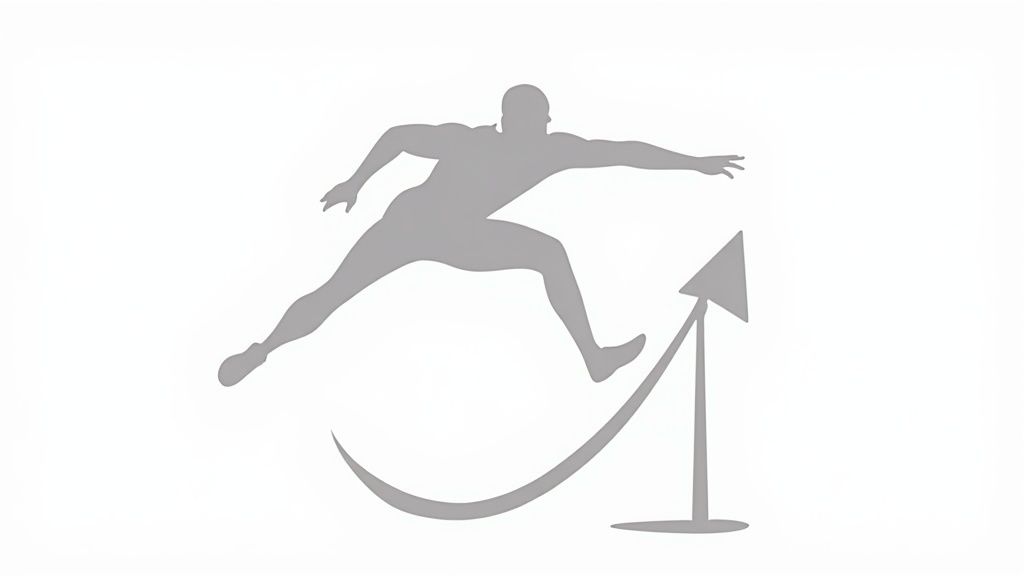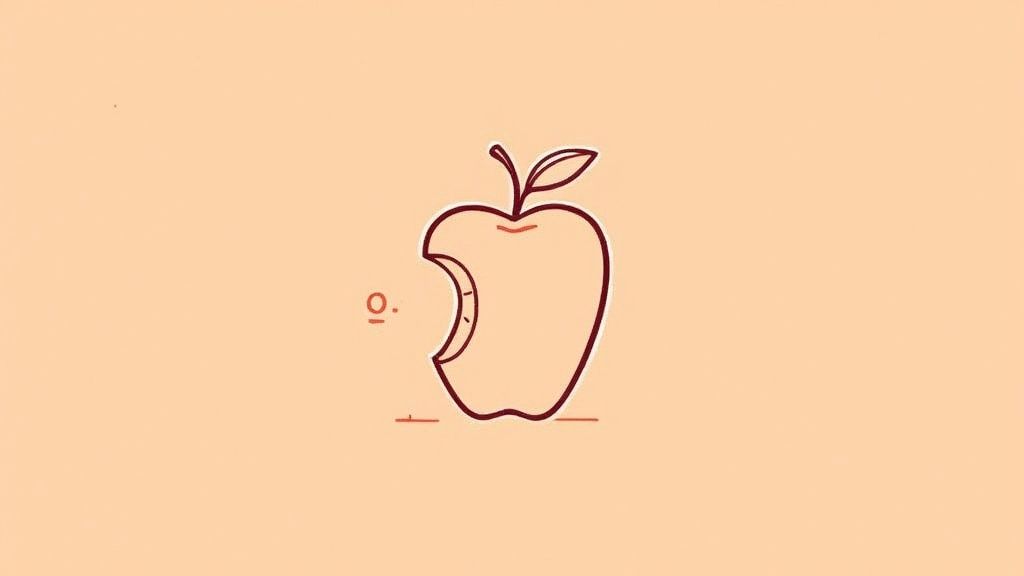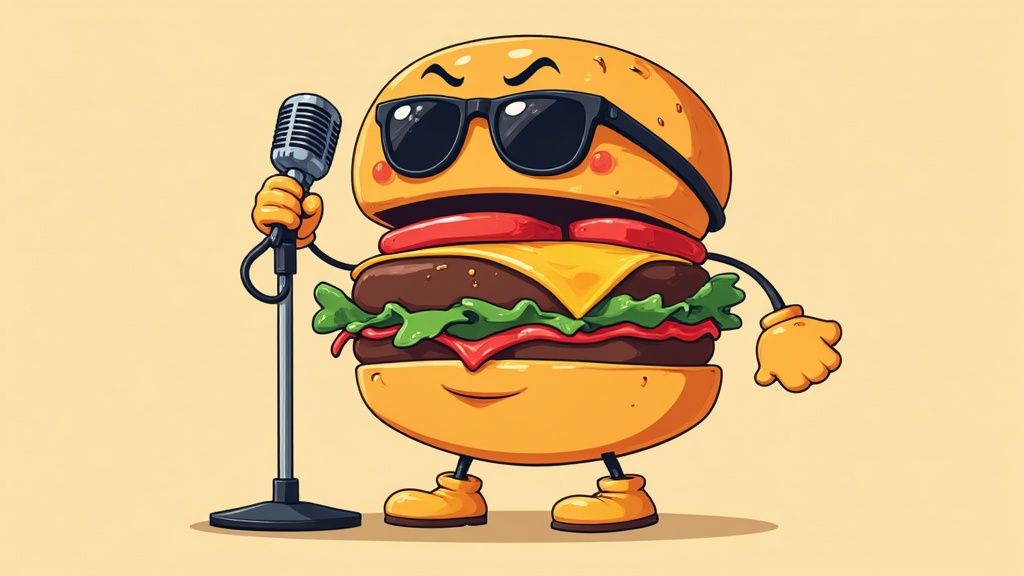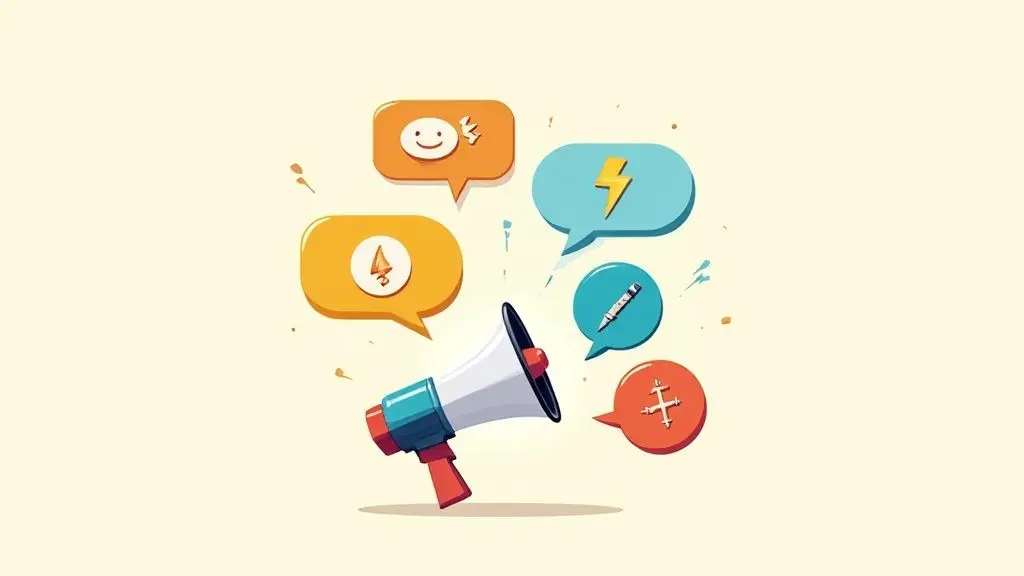Finding Your Brand's True Voice
Discover how to craft a compelling brand voice that sets you apart. This list of brand voice examples provides inspiration for solopreneurs, creators, career pivoters, coaches, and purpose-driven professionals. A strong brand voice is essential for attracting your ideal audience. Explore these diverse examples—from Nike's motivational tone to MailChimp's quirky style—and learn how to shape your own unique brand voice. See how brands like Apple and Innocent Drinks use distinct voices to connect with their customers, and discover how to create a similar impact for your brand.
1. Nike's Bold and Motivational Voice
Looking for potent brand voice examples? Look no further than Nike. Their brand voice resonates with a boldness and motivational energy that ignites action. It's a voice that speaks directly to the inner athlete in all of us, urging us to push beyond perceived limitations and strive for greatness. This is achieved through simple, direct language infused with powerful emotional appeals, encouraging consumers to conquer challenges and reach their full potential. Their now-iconic slogan, "Just Do It," perfectly encapsulates this philosophy, transforming a sportswear brand into a global movement that transcends sport and becomes a lifestyle. It’s a testament to how a strong brand voice can build a powerful connection with its audience.

Nike's brand voice is characterized by several key features: empowering and motivational language, simple and direct sentences, active voice, challenge-oriented messaging, and an inclusive yet aspirational tone. This combination creates a voice that's both accessible and inspiring, appealing to seasoned athletes and everyday individuals alike. Whether you’re a solopreneur seeking to differentiate your services, a creator searching for your unique position, a career pivoter needing direction, a coach looking to attract the right clients, or a purpose-driven professional yearning for more meaning, Nike's approach offers valuable insights.
This approach has several advantages. It forges strong emotional connections with consumers, creating a sense of shared purpose and belonging. The voice is instantly recognizable across various platforms, ensuring consistent brand identity. Moreover, its universality allows it to resonate in global markets, breaking down cultural barriers. The result? A powerful engine of customer loyalty that extends far beyond product features. Think about it – you're not just buying a pair of shoes; you're buying into a mindset.
However, even this powerful brand voice has its drawbacks. Maintaining such a strong, consistent voice across large marketing teams can be challenging, and the motivational tone can occasionally feel impersonal. Furthermore, in certain cultural contexts, the assertive messaging might be perceived as aggressive.
Numerous campaigns exemplify Nike's bold voice. The timeless "Just Do It" campaign, the COVID-19 "Play for the World" campaign – which declared, "If you ever dreamed of playing for millions around the world, now is your chance" – and the poignant Michael Jordan "Failure" commercial, where he states, "I've failed over and over again in my life. And that is why I succeed," all demonstrate the power of this approach.
So, how can you harness the energy of Nike’s approach for your own brand? Here are some actionable tips:
- Focus on the customer's potential, not limitations: Inspire them to see what they can achieve.
- Use action verbs and imperative statements: Encourage immediate action and engagement.
- Keep sentences short and impactful: Mirror the quick, decisive nature of athletic pursuits.
- Embrace the universal struggle of self-improvement: Connect with your audience on a deeper level.
- Maintain consistency across all touchpoints: From social media to email marketing, ensure your voice remains unified.
The success of Nike's brand voice can be attributed to the visionaries like Phil Knight (Nike founder), Dan Wieden (the creative mind behind "Just Do It"), and the countless celebrated global athletes featured in Nike campaigns. Their combined influence has cemented Nike's position as a global leader, proving that a strong brand voice is more than just marketing—it's a powerful tool for inspiring and connecting with people worldwide. Learn more about Nike's Bold and Motivational Voice
By understanding and adapting Nike’s strategies, you can create a brand voice that not only resonates with your target audience but also empowers them to reach their full potential. This is why Nike deserves its place on this list of brand voice examples – it stands as a testament to the power of motivational messaging in building a globally recognized and beloved brand.
2. Apple's Clean and Minimalist Voice
Apple's brand voice is a masterclass in saying more with less. It's characterized by simplicity, clarity, and an unwavering confidence that never feels boastful. This voice cuts through the noise, making even complex technology seem accessible and intuitive. By using concise language and often employing the second person, Apple establishes a direct connection with the consumer, transforming technical innovations into personal experiences. This approach makes you feel like you're part of something bigger, something innovative and exciting.

This minimalist phrasing, coupled with an emphasis on simplicity, creates a perception of effortless understanding. Imagine explaining the intricacies of a powerful processor, yet making it sound as straightforward as breathing. That's the magic of Apple's voice. It empowers you, the consumer, to grasp sophisticated concepts without feeling overwhelmed. Their confident, yet approachable tone resonates deeply, especially with those seeking premium products without the pretentiousness. Features like subtle humor and the occasional invented word further enhance this unique brand identity. Think "Think Different." It's concise, powerful, and instantly recognizable.
For solopreneurs, creators, career pivoters, coaches, and purpose-driven professionals, Apple's approach offers invaluable lessons in brand voice examples. Are you struggling to differentiate your service business? Embrace clarity and simplicity. Unsure about your content positioning? Let your confidence shine through, not with arrogance, but with the quiet assurance of knowing your value. Seeking more meaning in your work? Connect with your audience on a personal level, making them feel understood and empowered.
Examples of Apple's Brilliance:
- "Think Different" campaign: A timeless example of impactful minimalism.
- iPhone 13 Pro: "Oh. So. Pro.": Short, punchy, and brimming with understated confidence.
- iPad launch: "A magical and revolutionary device at an unbelievable price.": This perfectly balances innovation with accessibility.
- Product pages: Often employ phrases like "Incredible power. Incredibly simple." demonstrating the core of their messaging.
Tips for Implementing Apple's Approach:
- Eliminate unnecessary words: Brevity is key. Get to the point and make every word count.
- Use periods for emphasis: Even incomplete sentences can pack a powerful punch.
- Speak confidently about innovations without hyperbole: Let the product speak for itself.
- Focus on user benefits: Explain how your product or service will transform their lives.
- Create a sense of inevitability about your products: Position your offering as the natural next step.
Pros:
- Creates a perception of accessibility despite premium pricing
- Simplifies complex products
- Highly distinctive and recognizable
- Effectively communicates innovation without technical jargon
Cons:
- Can sometimes appear elitist
- Challenging to maintain across all product lines
- Simplicity can occasionally mask feature limitations
This approach, popularized by visionaries like Steve Jobs, Jony Ive, and Lee Clow, demonstrates the power of a carefully crafted brand voice. It's a testament to the idea that less can indeed be more. Want to delve deeper? Learn more about Apple's Clean and Minimalist Voice. By embracing the principles of simplicity, clarity, and confidence, you too can create a brand voice that resonates and inspires.
3. Innocent Drinks' Conversational and Playful Voice
Imagine a brand that chats with you like a friend, cracking jokes and sharing its little mishaps along the way. That's the magic of Innocent Drinks' conversational and playful brand voice. This approach fosters a genuine connection with consumers, making them feel like they're part of an inside joke rather than being subjected to a sales pitch. It's a brilliant example of how a distinct brand voice can elevate a business, and it's particularly inspiring for solopreneurs, aspiring creators, career pivoters, coaches, consultants, and purpose-driven professionals seeking to carve out their own unique space.

This brand voice example is all about being approachable and human. Innocent Drinks achieves this through casual language, witty banter, and a touch of self-deprecation. Think of it as the antithesis of corporate stiffness. They use first-person perspective, contractions, and even occasional handwritten elements to create a sense of intimacy. This strategy works by breaking down the traditional barriers between brand and consumer, fostering trust and loyalty. Looking at their packaging – phrases like "Stop looking at my bottom" on the base of bottles – or their email subject lines – "We made you a smoothie. And a hat." – immediately illustrates the power of this approach. Their social media posts, often declaring things like "We're made of 100% fruit, not lies," further solidify this playful, honest persona. Their annual "Big Knit" campaign, where they partner with charities and encourage people to knit tiny hats for their bottles, is another testament to their quirky and engaging communication style.
Features of Innocent's Brand Voice:
- Conversational and casual language: They talk to you, not at you.
- Gentle humor and wordplay: Making you smile is part of the brand experience.
- First-person perspective: Building a sense of personal connection.
- Deliberately naive tone: Adding to the charm and approachability.
- Transparency about business practices: Reinforcing trust and authenticity.
- Occasional handwritten elements: Adding a personal touch.
Why This Approach Works (Pros):
- Creates strong emotional connection and brand loyalty: People connect with brands that feel human.
- Highly distinctive in the beverage category: They stand out from the crowd.
- Supports their ethical, natural product positioning: The playful voice complements their product values.
- Encourages social media engagement and sharing: Their content is inherently shareable.
Potential Pitfalls (Cons):
- Can feel forced if not executed authentically: It needs to be genuine.
- May not translate well to serious communications: There's a time and place for playfulness.
- Risk of seeming childish in some contexts: Balance is key.
Tips for Implementing a Similar Brand Voice:
- Write as you speak, then edit for clarity: Keep it natural.
- Use contractions and colloquialisms: Embrace informality.
- Don't be afraid of simple language and short sentences: Clarity over complexity.
- Include your audience in jokes: Make them feel like part of the community.
- Be transparent about mistakes: Show your human side.
- Test copy by reading it aloud: Ensure it sounds conversational.
Innocent Drinks, pioneered by Richard Reed, Adam Balon, Jon Wright, and Dan Germain (Head of Brand and Creative), demonstrates that a conversational and playful brand voice can be incredibly effective. (Visit their website for more inspiration.) This approach is particularly relevant for those building service businesses, aspiring creators, career pivoters, coaches, and consultants. It allows you to connect with your audience on a deeper level, building trust and ultimately, loyalty. By showcasing your personality and values, you can create a brand that resonates and attracts the right people.
4. Wendy's Sassy and Irreverent Voice
Looking for a brand voice that truly cuts through the noise? Wendy's provides a powerful brand voice example, demonstrating how a bold, sassy, and irreverent tone can transform your brand into a social media powerhouse. This approach flips traditional corporate communication on its head, embracing humor, pop culture references, and even direct engagement (sometimes confrontational engagement) with competitors. This isn't just about posting funny tweets; it's about crafting a distinct personality that resonates with your target audience and sets you apart. This strategy has transformed Wendy's social media presence into entertainment content that drives engagement far beyond typical fast-food marketing, making it a standout example for anyone looking to build a memorable brand.

This brand voice example showcases the power of sharp wit and sarcasm, expertly woven with pop culture references to create instantly shareable content. Think of their infamous "Where's the beef?" campaign, a phrase that transcended advertising to become a cultural touchstone. Wendy's doesn't shy away from direct competitor callouts, often roasting rivals like McDonald's on Twitter with lines like, "@McDonald's So you'll still use frozen beef in MOST of your burgers in ALL of your restaurants? Asking for a friend." This bold tactic not only creates buzz but also positions Wendy's as the confident, quality-focused alternative. Their conversational tone and quick responses to current events further amplify their authenticity, making them feel less like a corporation and more like a witty friend. Remember their response to a Twitter user asking what to get at McDonald's? "A ride to Wendy's." Pure gold. They even solidified their sassy persona with an annual "National Roast Day" event on Twitter, further cementing their brand voice in the minds of consumers.
For solopreneurs, aspiring creators, career pivoters, coaches, consultants, and purpose-driven professionals, Wendy's offers a powerful lesson in differentiation. This brand voice example illustrates how a unique and engaging personality can attract the right audience and build a loyal following. Imagine translating this sass and wit to your specific niche, creating content that not only informs but also entertains.
Pros: Generates substantial organic engagement and earned media, appeals strongly to younger demographics, creates clear differentiation from competitors, and builds a personality that transcends product features.
Cons: The approach carries a high risk of controversies or missteps and requires an exceptional social media team. It may also alienate more conservative customers and can be challenging to maintain consistent sass across all platforms.
Tips for Implementing a Sassy and Irreverent Voice:
- Know your boundaries and establish clear guidelines: Humor is subjective, so define what's acceptable for your brand.
- Respond quickly but thoughtfully: Witty comebacks require quick thinking, but avoid impulsive reactions that could backfire.
- Balance sass with genuine customer service: Don't let the sass overshadow your commitment to customer satisfaction.
- Stay culturally relevant through constant monitoring: Pop culture moves fast, so stay updated on trends and current events.
- Don't force it – authenticity is key: If sass isn't a natural fit for your brand, it will feel forced and inauthentic.
- Have approval processes that don't kill spontaneity: Streamline your approval process to maintain the fresh, off-the-cuff feel.
Individuals like Amy Brown (former social media manager), Kurt Kane (Chief Concept and Marketing Officer), and VML (digital agency partner) were instrumental in popularizing this approach at Wendy's. Learn more about Wendy's Sassy and Irreverent Voice and explore how this brand voice example can inspire your own unique and engaging brand identity. Remember, this approach isn’t suitable for every brand, but if done right, it can be a powerful tool for connecting with your audience on a deeper level. This deserves its place on the list of brand voice examples because it demonstrates the immense power of a distinctive and well-executed brand personality in the digital age.
5. MailChimp's Friendly and Quirky Voice
Are you a solopreneur, aspiring creator, or career pivoter struggling to connect with your audience? Perhaps you're a coach or consultant with a fantastic offer but a brand voice that falls flat. MailChimp's friendly and quirky voice offers powerful inspiration for anyone seeking a distinctive and engaging brand identity. This approach brilliantly demonstrates how a brand voice can be both professional and playful, building trust while remaining undeniably likable. This is a prime example of effective brand voice, and that's why it deserves a spot on this list of brand voice examples.
MailChimp, the email marketing platform, has mastered the art of balancing technical expertise with a warm, conversational tone. They inject personality into every interaction, from accessible technical explanations to strategically placed humor and surprise "easter eggs." This unique blend helps demystify the often intimidating world of email marketing, creating memorable user experiences that foster genuine emotional connections. Think of it like this: they’re your supportive friend who also happens to be an email marketing whiz.
Features of MailChimp's voice include:
- Warm, conversational tone: They speak to you, not at you.
- Balanced professionalism and playfulness: Expertise doesn't have to be stuffy.
- Strategic use of humor: Laughter makes learning (and even email marketing) fun.
- Accessible technical explanations: Jargon-free clarity empowers users.
- Empathetic language: Recognizing user anxieties and offering reassurance.
- Easter eggs and surprise moments: Delightful little touches that make users smile.
These features translate into tangible benefits:
Pros:
- Makes a technical product feel approachable: No more intimidation factor.
- Creates memorable user experiences: Positive interactions build brand loyalty.
- Differentiates from other B2B SaaS companies: They stand out in a crowded market.
- Builds trust while remaining likable: Expertise with a human touch.
Cons:
- Can occasionally undermine perception of sophistication: Some enterprise clients might prefer a more formal approach.
- Challenging to scale across global markets: Humor and colloquialisms don't always translate well.
- May not resonate with all enterprise clients: Some may prefer a more traditional corporate tone.
Examples of MailChimp's quirky voice in action:
- High-five animation after sending campaigns: A small celebration of accomplishment.
- Pre-send anxiety acknowledgment: "Take a deep breath. Your campaign looks great." – Empathy at its finest.
- Error messages like "Everyone hits a snag sometimes": Reassurance and a touch of humor soften the blow.
- Freddie the mascot's presence throughout the platform: A consistent reminder of their playful personality.
Actionable Tips for Implementing a Similar Voice:
- Identify moments of user stress or confusion for empathetic messaging: Where can you offer reassurance and support?
- Create voice guidelines with concrete examples: Ensure consistency across your brand.
- Use plain language even for technical concepts: Clarity is key.
- Build in surprise moments of delight: Little touches go a long way.
- Test your voice across different user touchpoints: Maintain consistency across your website, social media, and email communications.
- Consider cultural nuances when expanding globally: Humor and colloquialisms may require adaptation.
MailChimp's distinctive voice was largely shaped by founders Ben Chestnut and Dan Kurzius, along with former Director of Content Kate Kiefer Lee and their talented in-house creative team. Learn more about MailChimp's Friendly and Quirky Voice.
For those of you seeking a brand voice that truly resonates, MailChimp's approach provides valuable insights. By embracing personality, empathy, and a touch of quirkiness, you can forge deeper connections with your audience, transforming mundane interactions into memorable experiences. This method is particularly effective for those building service businesses, posting online content, or pivoting careers and needing to stand out. If you’re a coach, consultant, or purpose-driven professional, injecting personality into your brand voice can be the key to attracting the right clients and making a genuine impact. Use MailChimp as a brand voice example and unlock the power of genuine connection.
6. Patagonia's Authentic and Activist Voice
Finding your brand voice can feel like searching for the perfect pitch in a vast wilderness. But some brands have not only found their voice but have also used it to inspire a movement. Patagonia, the outdoor clothing and gear company, serves as a powerful brand voice example, proving that authenticity and activism can resonate deeply with consumers. Their approach demonstrates that a strong brand voice isn't just about selling products; it's about standing for something bigger. This makes Patagonia an excellent brand voice example, particularly for purpose-driven professionals and those seeking to make a real difference.
Patagonia has crafted a brand voice defined by authenticity, environmental activism, and radical transparency. They communicate directly, with purpose, often challenging consumers to reconsider their consumption habits. This voice is consistent across all their platforms, from product descriptions highlighting environmental impact to hard-hitting environmental campaigns, weaving a cohesive narrative that positions the brand as an activist first and a retailer second. This distinct approach is why it deserves a place on this list of brand voice examples.
Features of Patagonia's Brand Voice:
- Direct and honest language: They don't shy away from complex issues or sugarcoat their message.
- Environmental focus: Sustainability and environmental protection are at the core of every communication.
- Call-to-action oriented: They encourage customers to take action, whether it's reducing consumption, supporting environmental causes, or demanding change.
- Educational content: Patagonia provides resources and information to help consumers make informed decisions.
- Value-driven messaging: Their communications emphasize their core values and their commitment to the planet.
- Anti-consumerist undertones: They challenge the traditional consumer mindset and promote responsible consumption.
Pros:
- Builds deep trust and loyalty: Transparency and consistent action foster a strong connection with customers.
- Attracts value-aligned customers: Their distinct voice draws in customers who share their values.
- Creates authentic differentiation: Their activism sets them apart in a crowded marketplace.
- Supports premium pricing through values alignment: Customers are willing to pay more for products aligned with their values.
Cons:
- Can alienate consumers with different political views: Their strong stance can be polarizing.
- Challenging to maintain authenticity at scale: As the company grows, maintaining this level of authenticity requires constant effort.
- May limit growth potential in some markets: Their anti-consumerist message may not resonate in all cultures.
Examples of Patagonia's Brand Voice in Action:
- "Don't Buy This Jacket" Black Friday campaign: A bold statement that challenged consumerism head-on.
- Product descriptions that highlight environmental impact: Transparency about the manufacturing process empowers consumers.
- Founder Yvon Chouinard's letter "Earth is now our only shareholder": A powerful demonstration of their commitment to the planet.
- Environmental grant program communications: Showcasing their dedication to supporting environmental initiatives. (www.patagonia.com)
Tips for Implementing a Similar Brand Voice:
- Lead with your values, not your products: Focus on what you stand for, not just what you sell.
- Back statements with concrete actions: Don't just talk the talk; walk the walk.
- Use plain language when discussing complex environmental issues: Make your message accessible to everyone.
- Tell stories of real people and impacts: Humanize your message and connect with your audience emotionally.
- Be willing to take controversial stands: Authenticity requires taking risks.
- Acknowledge your own imperfections and efforts to improve: Transparency builds trust.
Popularized By:
- Yvon Chouinard (founder)
- Vincent Stanley (Director of Philosophy)
- Rick Ridgeway (VP of Environmental Initiatives)
Patagonia's approach is particularly inspiring for solopreneurs, aspiring creators, career pivoters, coaches/consultants, and purpose-driven professionals. It demonstrates that you can build a successful brand by staying true to your values and using your voice to advocate for what you believe in. By focusing on your purpose and communicating authentically, you can attract a loyal following of customers who share your vision and create a brand that resonates far beyond the bottom line. For those seeking brand voice examples that demonstrate true impact, Patagonia is a beacon.
7. Dollar Shave Club's Humorous and Direct Voice
Are you tired of blending in? Do you dream of a brand voice that cuts through the noise and resonates with your audience? Look no further than Dollar Shave Club's humorous and direct approach, a prime example of how to use brand voice examples to build a powerful and memorable brand. This approach isn't just about cracking jokes; it's about connecting with your audience on a human level, addressing their pain points with refreshing honesty, and injecting a dose of personality into even the most mundane products. This is a particularly powerful strategy for solopreneurs, aspiring creators, career pivoters, coaches/consultants, and purpose-driven professionals who are seeking to differentiate themselves in a crowded marketplace.
Dollar Shave Club disrupted the razor industry by speaking directly to customer frustrations – the exorbitant prices and unnecessary complexity of traditional razor shopping. Their communications, infused with wit and irreverence, resonated with a male-focused but inclusive audience tired of being talked down to. This authentic and relatable voice positioned them as the refreshing alternative to overly serious legacy brands. Think about how this can translate to your own business. Are you addressing a real pain point for your target audience? Are you speaking their language?
How it Works:
This brand voice thrives on straightforward messaging and strategic humor. Instead of relying on industry jargon, Dollar Shave Club opts for colloquial expressions, creating a sense of familiarity and trust. They are problem-solution oriented, clearly outlining the issue and presenting their product as the answer. This resonates deeply with audiences who appreciate clear, concise, and relatable communication.
Features of this Brand Voice:
- Straightforward messaging: No fluff, just facts delivered with personality.
- Strategic use of humor: Laughter is memorable. They use it to make their point and stick in customers' minds.
- Male-focused but inclusive language: Broad appeal without alienating anyone.
- Colloquial expressions: Speaking like real people to real people.
- Rejection of industry jargon: Cutting through the noise and getting straight to the point.
- Problem-solution oriented: Addressing customer pain points directly and offering a clear solution.
Pros:
- Creates immediate brand recognition: Their distinct voice is instantly identifiable.
- Builds relatability and trust: Humor and honesty foster connection.
- Makes bathroom products engaging: Who knew razors could be this interesting?
- Effectively communicates value proposition: Clear, concise, and compelling.
Cons:
- Can occasionally cross taste boundaries: Humor is subjective and requires careful calibration.
- More challenging to expand to premium product lines: The irreverent tone may not suit a luxury image.
- May need adjustment for international markets: Humor doesn't always translate across cultures.
Examples of Dollar Shave Club's Voice in Action:
- Original viral video: "Our Blades Are F***ing Great" – This launched them into the spotlight.
- Email subject lines: "It's like a bowling alley… for your face" – Intriguing and memorable.
- Product descriptions: "The Executive razor is like a personal assistant that shaves you" – Clever and relatable.
- Bathroom Notes content marketing series: Extending their humor and personality beyond product descriptions.
Tips for Implementing This Approach:
- Address customer pain points directly: Show them you understand their struggles.
- Don't be afraid to call out industry absurdities: Challenge the status quo.
- Use colloquial language your customers actually use: Speak their language.
- Test humorous content with diverse audiences: Ensure your humor resonates and doesn't offend.
- Create a tone spectrum for different types of communications: Adapt your tone based on the context.
- Find the human truth in mundane products: Even everyday items can be made engaging.
Learn more about Dollar Shave Club's Humorous and Direct Voice
Dollar Shave Club's success demonstrates the power of a well-crafted brand voice. Their humorous and direct approach transformed a mundane product into a cultural phenomenon. By understanding their strategy and adapting it to your own brand, you can create a voice that resonates with your target audience, builds lasting connections, and ultimately drives business growth. This "brand voice examples" success story showcases how powerful authenticity and humor can be. Dollar Shave Club was acquired by Unilever for $1 billion in 2016, proving that a strong brand voice translates to real business value. They were popularized by Michael Dubin (founder) and Lucia Aniello (director of the original viral video). Take inspiration from their story and dare to be different.
7 Brand Voice Styles Compared
| Brand Voice | Implementation Complexity 🔄 | Resource Requirements 🔄 | Expected Outcomes 📊 | Ideal Use Cases 💡 | Key Advantages ⭐ |
|---|---|---|---|---|---|
| Nike's Bold and Motivational | Medium – requires consistent team alignment | Moderate – creative and emotional copywriting | Strong emotional connection and loyalty | Sports, fitness, lifestyle brands | Highly recognizable, inspiring |
| Apple’s Clean and Minimalist | High – precision in language and tone | High – skilled content strategists and designers | Clear perception of innovation and simplicity | Technology, premium products | Distinctive, simplifies complexity |
| Innocent Drinks' Conversational | Medium – needs authentic casual tone | Moderate – content with humor and personality | Strong brand loyalty and social engagement | Consumer goods, especially food & beverage | Distinctive, humanizes brand |
| Wendy's Sassy and Irreverent | High – real-time social media agility | High – expert social media team | High engagement and viral reach | Social media, youth-oriented, fast food | Highly engaging, differentiates competitively |
| MailChimp's Friendly and Quirky | Medium – balances professionalism and playfulness | Moderate – creative and technical writing | Approachable brand with strong user trust | B2B SaaS, technical products | Builds trust with personality |
| Patagonia's Authentic and Activist | Medium-High – requires value consistency | Moderate – content focused on activism and education | Deep trust and loyal, value-aligned customers | Purpose-driven brands, environmental sectors | Builds authenticity and premium differentiation |
| Dollar Shave Club's Humorous and Direct | Medium – balancing humor and clarity | Moderate – creative copy with directness | Memorable and relatable brand perception | Disruptive brands, direct-to-consumer products | Engaging, breaks industry jargon |
Crafting Your Authentic Brand Voice
From Nike's motivational roar to MailChimp's quirky charm, these brand voice examples showcase the power of distinct communication. The key takeaway? Authenticity reigns supreme. Just as Innocent Drinks found its playful voice, you too can discover a tone that resonates with your audience and amplifies your message. Remember the most important aspects of developing your brand voice: understanding your values, knowing your audience, and daring to be different. Mastering these concepts will not only strengthen your brand identity but also forge deeper connections with the people who matter most – your customers.
Developing a brand voice is just one part of a larger effort towards crafting an authentic brand identity. For a deeper dive into building an authentic brand, explore Authentizität im Digitalen Marketing: Jenseits von Buzzwords from CSW.AGENCY, which offers valuable insights into building a truly authentic presence online.
Ultimately, finding your voice is a journey of self-discovery for your brand. It's about unearthing what makes you unique and letting that shine through every piece of content you create. Ready to craft a captivating brand voice and share your unique story with the world? Henri Den can help you define, refine, and amplify your message. Explore the power of authentic storytelling with Henri Den and unlock your brand's true potential.





